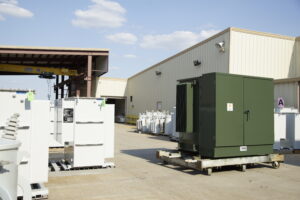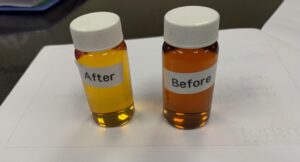By Mark Stone, Training Manager
Transformer oil plays a pivotal role in the operation and longevity of electrical transformers, serving four vital functions. Firstly, it acts as a heat dissipater, ensuring that the core and coil of the transformer remain at optimal temperatures by facilitating thermal syphoning. Secondly, the oil must possess dielectric capabilities to insulate and protect the transformer’s components. Most crucially, it shields the solid insulation, typically paper, from damage that could weaken the transformer’s tensile strength and reduce its overall lifespan. Furthermore, transformer oil enables easy monitoring through regular testing in a laboratory setting, offering valuable insights into the equipment’s health. This article delves into the various types of transformer fluids, their colors, and the critical importance of proper maintenance practices for the safe and efficient operation of electrical transformers.
What is the purpose of transformer oil?
The transformer oil serves four essential functions.
One: It needs to disperse heat from the core and coil. The oil in a transformer doesn’t just sit there. As it heats up, the oil will rise to the top and then go out into the tops of the radiator’s tubes. Here it will start to cool, it then starts to work its way down the radiator tubes and then back into the transformer at the bottom of the cooling tubes. The name of this process is Thermal Syphoning.
Two: It needs to have dielectric capabilities.
Three: We should prioritize the oil’s ability to safeguard the solid insulation (paper) within the transformer. Once the damage is done to the paper the tensile strength will weaken making the paper weaker, shortening the life of the transformer.
of the transformer.
Fourth: Is not a function of the oil, but the advantage of oil is that you can pull a representative sample from the transformer and send it to a lab and see how the transformer is operating. There is a battery of different tests that are done on an oil sample ranging from oil aging tests to DGA tests and of course moisture content.
What types of fluid?
Manufacturers produce a wide variety of transformer fluids today. The most prevalent is still mineral oil, with quite a few different refineries that refine mineral oil. There are 2 types of transformer oil, Type 1 and type 2. Type 1 is an uninhibited oil and Type 2 has an oxidation inhibitor added to it. Oxygen is an aging accelerator when it gets inside the transformer. With most of the oxygen getting in through leaks. This is why it is so important to do visual inspections and repair any leaks that you find. The oxidation inhibitor will get used up after time, what that period comes down to is how much oxygen is in the transformer. The higher the amount of oxygen, the faster the inhibitor will deplete. Type 2 inhibited oil should be recommended.
The oil in the transformer also has a breakdown voltage (BDV). The dielectric breakdown voltage of an insulating liquid is of importance as a measure of the liquid’s ability to withstand electric stress without failure. This test looks for contaminants such as water, dirt, cellulosic fibers, or conducting particles in the liquid, one or more of which may be present. Lowering the dielectric of the oil. Parameters for ASTM D 877 and D 1816 Dielectric test are located in the IEEE Standard C57.106
What is the color of transformer fluids?
There are a lot of different types of fluids and natural and synthetic esters fluids. So, It all depends on the application of the transformer and where you are going to place the transformer. So the color of oil is dependent on what type of fluid it is.
Some fluids like oil when brand new should be water white(clear) but as they age the color will change from water white to a dark brown even black if there is carbon build up in the transformer.
brown even black if there is carbon build up in the transformer.
Some of the newer Natural esters are a light green tint. And of course, there are fluids out there that longer produced but, we might still have them in our electrical system, So, we need to be very careful if one of our in-service transformers develops a leak. When the fluid in the transformer is no longer in production, you must locate a compatible replacement fluid for the leaking transformer.
We have to remember that the most important reason why the fluid is in our transformers is to protect the solid insulation. So the good thing about oil is that when it gets questionable or unacceptable oil test results, you can clean it up and bring it back to acceptable levels.
Oil Processing (Hot Oil Cleaning)
The oxidation decay products are aggressive toward the solid insulation. This shortens the life of the equipment because it shortens the insulation life.
Hot oil cleaning removes these oxidation decay products including sludges from mineral oil-immersed transformers. The old dirty oil removed from the bottom of the transformer through an oil processor and then returned to the transformer. Depending on the test results and how many gallons of oil are in the transformer, will dictate how many passes are needed to bring your results back to acceptable levels. If all our test results are acceptable except the Oxidation Inhibitor, Southwest Electric can also do a reinbahiting process on your transformers. It is the same as Hot Oil Cleaning just a few less circulations through the oil processor saving time and money.
Want to learn more about transformer oil? Check out our transformer oil YouTube series:




Still have questions or want to learn more about Southwest Electric’s Transformer capabilities please call 833-YOUR-SWE.